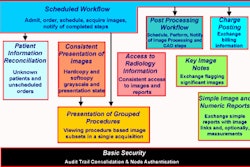A new company has arrived on the PACS scene with a method of integrating and optimizing digital image management networks. While not a full-service PACS company, Acuo Technologies says its software can help imaging facilities speed up their networks and make them operate more effectively across multiple locations.
Acuo has specifically targeted the image storage and distribution piece of PACS. The firm’s technology combines two image distribution principles that are sometimes viewed as mutually exclusive: image routing and on-demand image access. The company believes it has found a way to make both concepts work together in a way that provides faster, more efficient image access to users.
The company’s AcuoMed software is based on routing DICOM-based images to archives distributed throughout an enterprise, where they are cached in preparation for being recalled by users. The company believes that its model can offer a 13-fold improvement in image distribution times over a PACS that uses a traditional centralized archiving strategy, according to Paul Bottum, a founder and president of the company.
Acuo installs its AcuoMed servers as part of a hospital’s existing network. The servers can either serve as a site’s primary archive, or can run in parallel to the main archive. Any type of Windows-compliant archiving media can be used, Bottum said.
Once installed, the technology uses AcuoMed to route images. Using the extensible markup language (XML, a format for Web-based structured data and documents), AcuoMed moves data around a network based on physician workflow. To reduce distribution times, the software only moves that data needed by the user, Bottum said. For example, in a large multislice CT set of images, only a few images might be annotated and thus would be the key images distributed by the system.
AcuoMed is also capable of routing images between image management networks installed by different vendors, or between networks installed at different sites. The system can thus free healthcare systems from having to use the same vendor for all of their PACS installations across a multisite enterprise, Bottum said.
Sites that haven’t yet adopted PACS can also deploy AcuoMed. Such a facility would simply attach the archive of its choice to the AcuoMed server, and there are a number of viewing applications that could be plugged into the system, according to Bottum.
AcuoMed is based on the Microsoft Windows 2000 operating system, and is optimized for Intel hardware. Using the Wintel platform enables the company to keep the cost of an AcuoMed installation down relative to more proprietary solutions, Bottum said. In addition, the company is working closely with Intel, and the Silicon Valley hardware giant is interested in partnering with Acuo to use the company’s software in other industries.
Acuo was founded in January of 2000. Two of the company’s founding engineers were employed at 3M when that company was still active in medical imaging, and had developed Windows NT-based image management software that was installed at the Mayo Clinic in Rochester, MN. For his part, Bottum has been associated with a number of high-tech healthcare firms, including angioplasty firm SciMed Life Systems (now a part of Boston Scientific) and orthopedic device maker Spinetech (now a division of Sulzer Medica).
Acuo won Food and Drug Administration clearance for AcuoMed in November 2000, and spent the next 18 months fine-tuning the software and testing it in pilot demonstrations. The software has been installed at Abbott Northwestern Hospital in Minneapolis, an Allina Hospitals & Clinics facility that serves as Acuo’s alpha-beta site.
Acuo launched its sales effort with a product demonstration earlier this month at Aurora Health Care’s St. Luke’s Medical Center in Milwaukee. One of the unique advantages of AcuoMed is that it can be installed and working in just a few hours -- far faster than the time it would take to put in a digital image management network. Potential customers can install the system and use it in a test environment before committing to a purchase, as Aurora did.
Bottum said Acuo is initially selling the product directly, and is also pursuing OEM agreements with PACS or HIS/RIS vendors.
By Brian CaseyAuntMinnie.com staff writer
May 29, 2002
Copyright © 2002 AuntMinnie.com


















